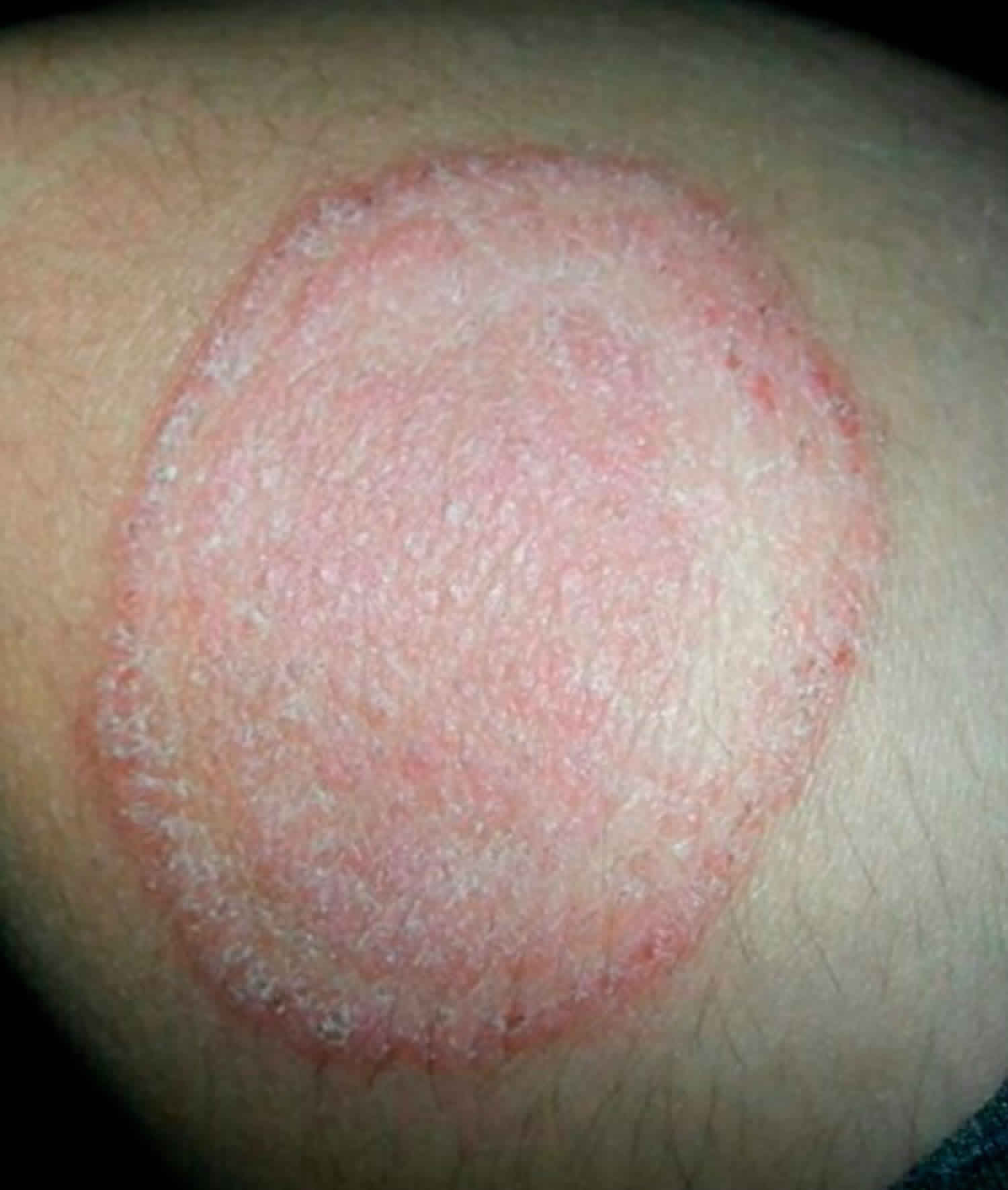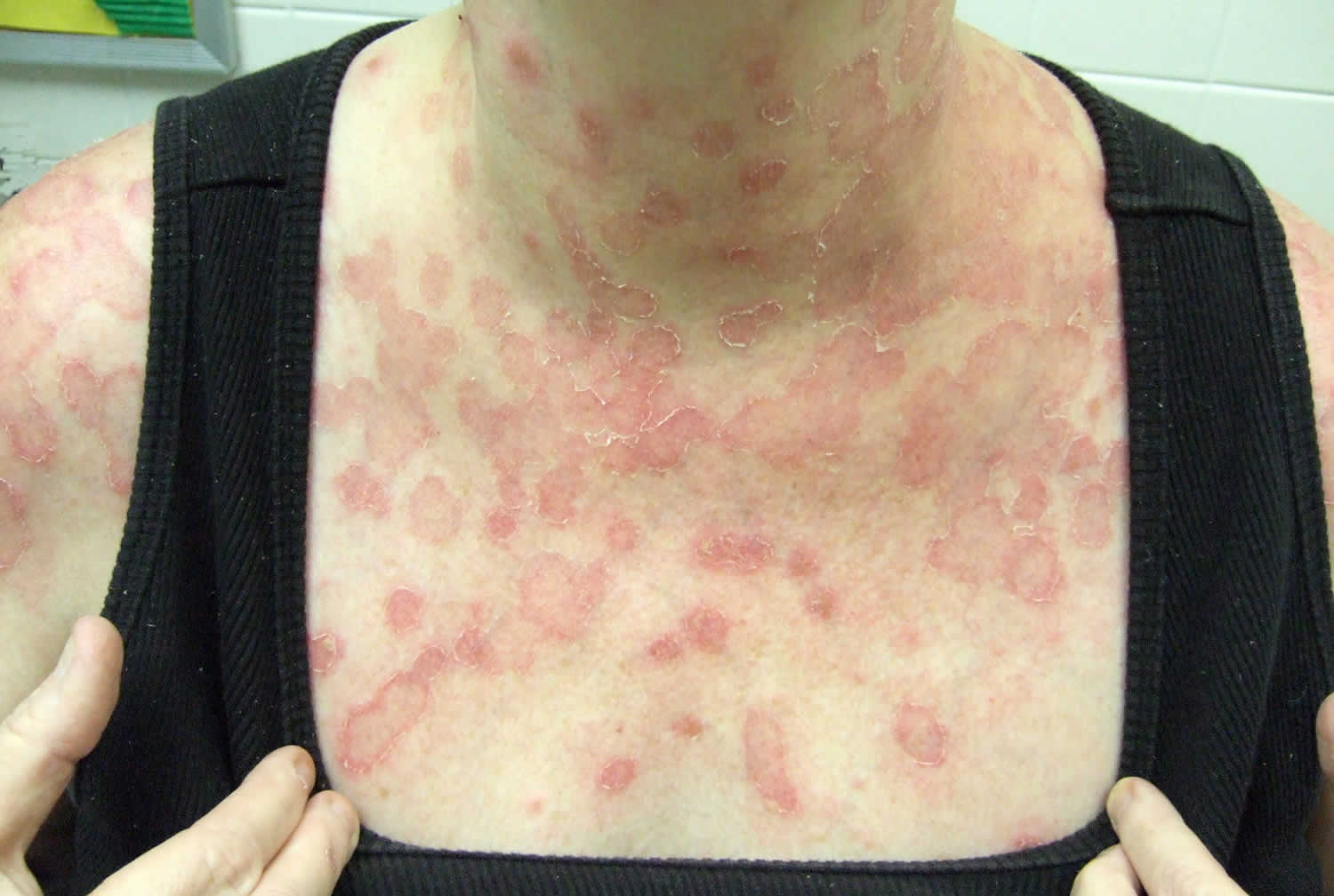What is tinea corporis
Tinea corporis is also known as ringworm of the body, tinea circinata or simply ringworm, is a surface (superficial) dermatophyte fungus infection of the skin of your trunk, legs or arms. Tinea corporis may be passed to humans by direct contact with infected people, infected animals, contaminated objects (such as towels or locker room floors), or the soil. Tinea infections are commonly called ringworm because some may form a ring-like pattern or round or oval red scaly patches, often less red and scaly in the middle or healed in the middle. on affected areas of the body. Sometimes one ring arises inside another older ring. No actual worm is involved.
Tinea corporis typically begins as a flat scaly area on the skin, which may be red and itchy. This patch develops a slightly raised border that expands outward — forming a roughly circular ring. The contours of the ring may be quite irregular, resembling the wavy outline of a snake or a worm.
The interior of the ring may be clear, scaly or marked with a scattering of red bumps. In some people, several rings develop at the same time and may overlap.
There are several kinds of tinea corporis (ringworm), including:
- Majocchi’s granuloma, a deeper fungal infection of skin, hair, and hair follicles. It is most common in women who shave their legs.
- Tinea corporis gladiatorum, a special name given to tinea corporis spread by skin-to-skin contact between wrestlers.
- Tinea imbricata, a form of tinea corporis seen in Central and South America, Asia, and the South Pacific.
In different parts of the world, different species cause tinea corporis. Trichophyton rubrum (T. rubrum) is the most common cause. Infection often comes from the feet (tinea pedis) or nails (tinea unguium) originally. Microsporum canis (M. canis) from cats and dogs, and Trichophyton verrucosum, from farm cattle, are also common.
Tinea corporis may occur in people of all ages, of all races, and of both sexes.
People who are more likely to develop tinea corporis include:
- Children
- Women of child-bearing age who come into contact with infected children
- People who have another tinea infection elsewhere on their bodies: tinea capitis (scalp), tinea faciei (face), tinea barbae (beard area), tinea cruris (groin), tinea pedis (feet), or tinea unguium (fingernails or toenails)
- Athletes, especially those involved in contact sports
- People in frequent contact with animals, especially cats, dogs, horses, and cattle
- People with weakened immune systems
- People who sweat heavily
- People who live in warmer, more humid climates.
If you suspect that you have ringworm or tinea corporis, you might try one of the following over-the-counter antifungal creams or lotions:
- Terbinafine
- Clotrimazole
- Miconazole
Apply the antifungal cream to each lesion and to the normal-appearing skin 2 cm beyond the border of the affected skin for at least 2 weeks until the area is completely clear of the lesion. Because ringworm is very contagious, avoid contact sports until lesions have been treated for a minimum of 48 hours. Do not share towels, hats, or clothing with others until the lesions are healed.
Since people often have tinea infections on more than one body part, examine yourself for other ringworm infections, such as on the face (tinea faciei), in the beard area (tinea barbae), in the groin (tinea cruris, jock itch), or on the feet (tinea pedis, athlete’s foot).
Have any household pets evaluated by a veterinarian to make sure that they do not have a fungal (ie, dermatophyte) infection. If the veterinarian discovers an infection, be sure to have the animal treated.
Mild ringworm often responds to antifungal medications that you apply to your skin. For more-severe infections, you may need to take antifungal pills for several weeks.
For a mild case of ringworm, you can apply an over-the-counter antifungal lotion or cream. Examples include clotrimazole (Lotrimin AF) and terbinafine (Lamisil AT). If over-the-counter antifungal treatments don’t work, you may need prescription-strength antifungal medications — such as creams or lotions that you apply to the affected skin. If your infection is particularly severe or extensive, your doctor might prescribe antifungal pills.
Figure 1. Tinea corporis rash
Is tinea corporis contagious?
Yes, tinea corporis (ringworm) is very contagious. Tinea corporis may be passed to humans by direct contact with infected people, infected animals, contaminated objects (such as towels or locker room floors), or the soil. You avoid contact sports until your skin lesions have been treated for a minimum of 48 hours with antifungal creams or lotions. Do not share towels, hats, or clothing with others until the lesions are healed.
If large areas of your body are affected or if the lesions do not improve after 1–2 weeks of applying over-the-counter antifungal creams, see your doctor for an evaluation.
Tinea corporis causes
Tinea corporis (ringworm) is a contagious fungal infection caused by mold-like parasites that live on the cells in the outer layer of your skin. It can be spread in the following ways:
- Human to human. Ringworm often spreads by direct, skin-to-skin contact with an infected person.
- Animal to human. You can contract ringworm by touching an animal with ringworm. Ringworm can spread while petting or grooming dogs or cats. It’s also fairly common in cows.
- Object to human. Ringworm can spread by contact with objects or surfaces that an infected person or animal has recently touched or rubbed against, such as clothing, towels, bedding and linens, combs, and brushes.
- Soil to human. In rare cases, ringworm can be spread to humans by contact with infected soil. Infection would most likely occur only from prolonged contact with highly infected soil.
Risk factors for getting tinea corporis
You’re at higher risk of tinea corporis of the body if you:
- Live in a warm climate
- Have close contact with an infected person or animal
- Share clothing, bedding or towels with someone who has a fungal infection
- Participate in sports that feature skin-to-skin contact, such as wrestling
- Wear tight or restrictive clothing
- Have a weakened immune system
Tinea corporis prevention
Tinea corporis is difficult to prevent. The fungus that causes tinea corporis is common and contagious even before symptoms appear. Help reduce your risk of tinea corporis by taking these steps:
- Educate yourself and others. Be aware of the risk of tinea corporis from infected people or pets. Tell your children about tinea corporis, what to watch for and how to avoid the infection.
- Keep clean. Wash your hands often to avoid the spread of infection. Keep common or shared areas clean, especially in schools, child care centers, gyms and locker rooms.
- Stay cool and dry. Don’t wear thick clothing for long periods of time in warm, humid weather. Avoid excessive sweating.
- Avoid infected animals. The infection often looks like a patch of skin where fur is missing. In some cases, though, you may not notice any signs of the disease. Ask your veterinarian to check your pets and domesticated animals for tinea corporis.
- Don’t share personal items. Don’t let others use your clothing, towels, hairbrushes or other personal items. Refrain from borrowing these items from others as well.
Tinea corporis symptoms
Tinea corporis may be acute (sudden onset and rapid spread) or chronic (slow extension of a mild, barely inflamed, rash). It usually affects exposed areas but may also spread from other infected sites.
Acute tinea corporis presents as itchy inflamed red patches and may be pustular. The cause is often infection by an animal (zoophilic) fungus such as Microsporum canis.
Chronic tinea corporis tends to be most prominent in body folds (spreading from tinea cruris). Trichophyton rubrum is the most common cause. If widespread, the condition tends to be stubborn to treat and prone to recurrence. This is possibly due to a decreased natural skin resistance to fungi or because of reinfection from the environment.
The most common locations for tinea corporis or ringworm include the following:
- Neck
- Arms
- Legs
- Trunk (chest, abdomen, back)
Tinea corporis appears as red ring-shaped patches with a raised scaly border ranging from 1 to 10 cm. The central area may be clear of any redness. The border of the affected skin may contain blisters, bumps, or scabs.
Tinea corporis may cause itching or burning, especially in people with weak immune systems.
- Majocchi granuloma describes tinea corporis involving the hair follicles resulting in pustules and nodules.
- Kerion is an inflamed fungal abscess. It presents as a boggy mass studied with pustules, often with satellite spots. It is often confused with a large boil or carbuncle or a tumour such as a skin cancer.
Tinea imbricata is due to Trichophyton concentricum and occurs in the Pacific Islands and other tropical areas. It results in brown scaly concentric rings.
Non-fungal conditions resembling tinea corporis include:
- Impetigo
- Seborrheic dermatitis
- Psoriasis
- Discoid eczema
- Lichen simplex
- Contact allergic dermatitis
- Pityriasis rosea
Tinea corporis complications
A fungal infection rarely spreads below the surface of the skin to cause serious illness. But people with weak immune systems, such as those with HIV/AIDS, may find it difficult to get rid of the infection.
Tinea corporis diagnosis
Your doctor might be able to diagnose ringworm simply by looking at it. If the diagnosis isn’t clear-cut, he or she may want to take some skin scrapings from the affected area so they can be examined under a microscope.
In order to confirm the diagnosis of tinea corporis (ringworm), your doctor might scrape some surface skin material (scales) onto a slide and examine them under a microscope. This procedure, called a KOH (potassium hydroxide) preparation, allows the doctor to look for tell-tale signs of fungal infection.
Occasionally, the diagnosis is made on skin biopsy because of characteristic histopathological features of tinea corporis and organisms may be found in the outside layers of the skin.
Tinea corporis treatment
Once the diagnosis of ringworm has been confirmed, your physician will likely start treatment with an antifungal medication. Most infections can be treated with prescription-strength topical antifungal creams and lotions, including:
- Terbinafine
- Clotrimazole
- Miconazole
- Econazole
- Oxiconazole
- Ciclopirox
- Ketoconazole
- Sulconazole
- Naftifine
- Butenafine
Rarely, more extensive infections or those not improving with topical antifungal medications may require 3–4 weeks of treatment with oral antifungal pills, including:
- Terbinafine
- Itraconazole
- Griseofulvin
- Fluconazole
- Ketoconazole
The tinea corporis (ringworm) should go away within 4–6 weeks after using effective treatment.






